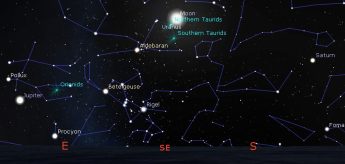This Week’s Sky at a Glance, 2025 Nov 1 – Nov 8
This Week’s Sky at a Glance, 2025 Nov 1 – Nov 8
With the time change this weekend there will likely be much griping about the practice. There will be mention of the inconvenience of resetting old-fashioned clocks, driving home in the dark, increases in vehicle accidents and heart attacks. I checked out a reference to a study in the Southern USA that showed an increase in fatal vehicle accidents during the week after time changes. There was a 5% increase, but only for the spring change to DST and only in the morning; back to darkness just when people were finally getting daylight for commuting. You won’t drive home from work in the dark as much if we stay on DST throughout winter but you can’t have it both ways. On DST sunrise would be after 8 am from November through February, with two weeks of that after 9 am. Our circadian rhythm needs morning sunshine.
As an amateur astronomer I don’t enjoy waiting until very late evening in summer to share views through my telescope. However, most people love the extra evening light during the outdoor months. Whereas the biggest beef against the time change is the temporary disruption of our biological clock, I suggest we start it at 2 am on the Saturday of the Victoria Day weekend to allow most people two or three days to adjust before returning to work or school. Saturday morning of Thanksgiving weekend is a logical time to fall back to Standard Time since summer activities have ceased.
This Week in the Solar System
Saturday’s sunrise in Moncton is at 8:00 and sunset will occur at 6:04, giving 10 hours, 4 minutes of daylight (8:03 and 6:11 in Saint John). Next Saturday the Sun will rise at 7:10 and set at 4:54, giving 9 hours, 44 minutes of daylight (7:13 and 5:02 in Saint John). Set your timepieces back one hour at 2 am Sunday.
The Moon is full and at perigee on Wednesday, making this the closest full Moon of the year. Expect extreme tides near the end of the week. The Moon is near Saturn on Sunday and near the Pleiades Thursday. This weekend Mercury is low in the southwest, setting about 59 minutes after sunset, with Mars two binocular widths to its right. Mercury would be difficult to see with binoculars, Mars is much dimmer. Saturn is highest and best for observing around 9:30 pm midweek, and Jupiter rises below the Gemini Twins a half hour later. Venus rises in Virgo to the lower left of Spica at 5:50 am midweek, when Jupiter is at its highest to the south. Binocular comet 2025 A6 Lemmon will be dimming and getting lower as it moves across the bottom of Ophiuchus over the week. See the Heavens Above website for its location at any time. The South Taurid meteor shower peaks on Wednesday, one week before the North Taurids, but bright moonlight will make meteor observing difficult,
The Saint John Astronomy Club meets in the Rockwood Park Interpretation Centre this Saturday at 7 pm. Tune in to the Sunday Night Astronomy Show at 8 pm on the YouTube channel and Facebook page of Astronomy by the Bay.

